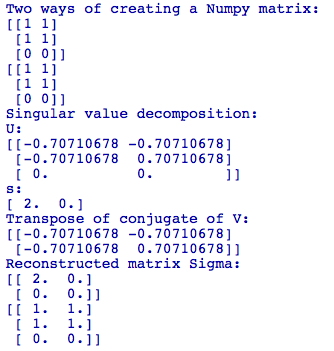To illustrate some of the similarities and differences between the linear algebra features of Sage and NumPy, we'll repeat an earlier example in which we computed the singular value decomposition of a matrix:
import numpy as np
print "Two ways of creating a Numpy matrix:"
A = np.matrix('1 1; 1 1; 0 0') # Matlab syntax
print(A)
A2 = np.matrix([[1,1], [1,1], [0,0]])
print(A2)
print("Singular value decomposition:")
U, s, Vstar = np.linalg.svd(A, full_matrices=False)
print("U:")
print(U)
print("s:")
print(s)
print("Transpose of conjugate of V:")
print(Vstar)
Sigma = np.diag(s)
print("Reconstructed matrix Sigma:")
print(Sigma)
print(np.dot(U, np.dot(Sigma, Vstar)))The result should look like this:




